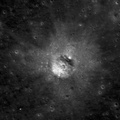
WIKIARCHIVES.SPACE
The Human Spaceflight Archive

This crater in the floor of Van de Graaff crater has a high reflectance ejecta blanket compared to the surrounding low reflectance material. The contrast in albedo is due to the crater excavating "fresh" or "immature" material from underneath the surface. Image width is 650 meters (2132 feet); NAC Image M110472904R; 30° incidence angle.
Information
- Taken in
- Author
- NASA/GSFC/Arizona State University
- Description
-
This crater in the floor of Van de Graaff crater has a high reflectance ejecta blanket compared to the surrounding low reflectance material. The contrast in albedo is due to the crater excavating "fresh" or "immature" material from underneath the surface. Image width is 650 meters (2132 feet); NAC Image M110472904R; 30° incidence angle.
NASA's Goddard Space Flight Center built and manages the mission for the Exploration Systems Mission Directorate at NASA Headquarters in Washington. The Lunar Reconnaissance Orbiter Camera was designed to acquire data for landing site certification and to conduct polar illumination studies and global mapping. Operated by Arizona State University, LROC consists of a pair of narrow-angle cameras (NAC) and a single wide-angle camera (WAC). The mission is expected to return over 70 terabytes of image data.
- Created on
- Wednesday 22 September 2010
- Albums
- US SPACE PROGRAM / PROBES / MOON / LRO/LCROSS / Mission Photos (Edited)
- Source link
- https://photojournal.jpl.nasa.gov
- Visits
- 18
- Rating score
- no rate
- Rate this photo
- License
- Public Domain
- Modified by WikiArchives
- No (original)
- Downloads
- 0
Powered by Piwigo
